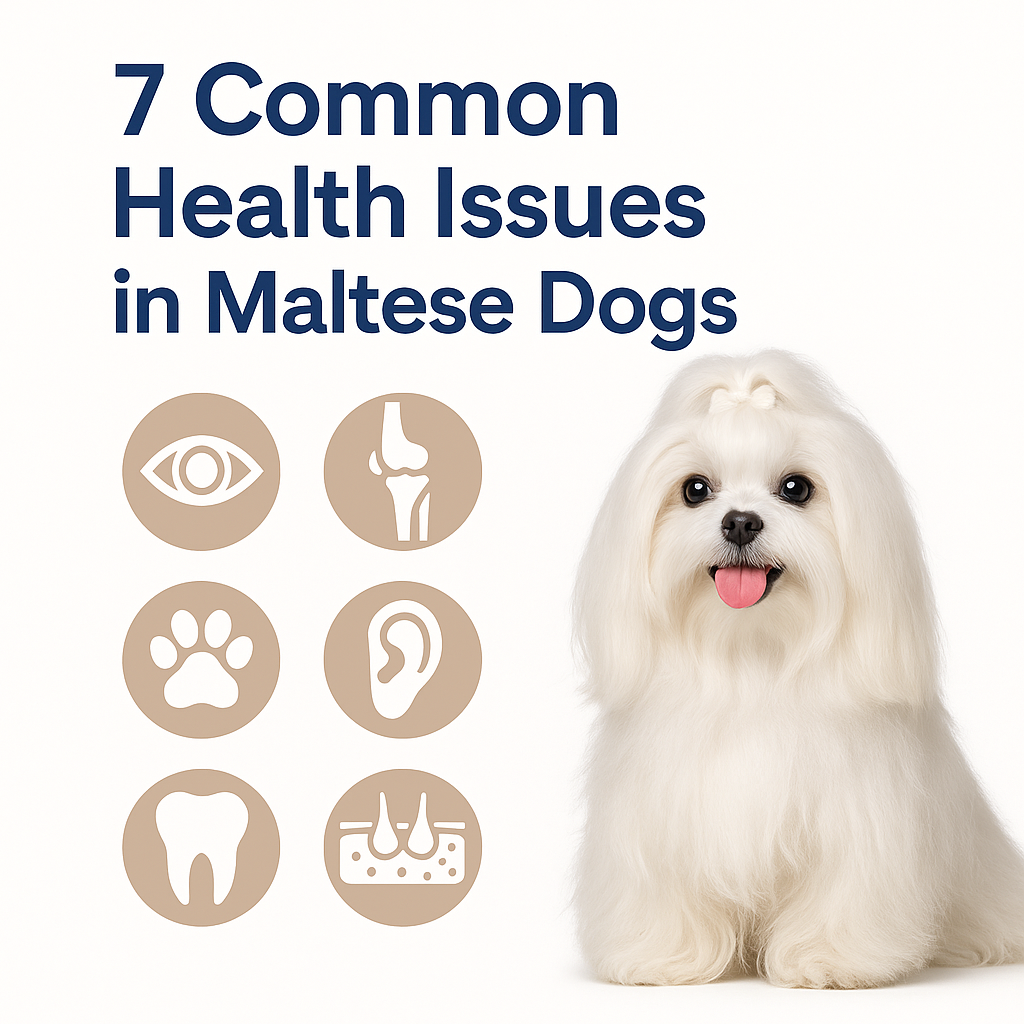
🐶 7 Common Health Issues in Maltese Dogs – Prevention and Care Tips for Owners
7 Common Health Issues in Maltese Dogs – Prevention and Care Tips for Owners
Why Do Maltese Dogs Require Special Health Attention?
The Maltese is a charming and affectionate toy breed, admired for its long white coat and lively personality.
However, due to their small size, genetic traits, and sensitive anatomy, they are more vulnerable to certain health conditions.
To keep your Maltese happy and healthy, it’s essential to understand the most common health issues in Maltese dogs, and how to prevent and manage them effectively.
⚠️ 7 Common Health Issues in Maltese Dogs
1. Tear Stains and Eye Problems
Maltese dogs often suffer from tear staining, dry eyes, conjunctivitis, and corneal irritation due to their prominent eyes and shallow sockets.
-
Prevention: Gently wipe the eyes daily with a tear-stain remover
-
Management: Anti-inflammatory eye drops or antibiotics, as prescribed
2. Patellar Luxation
This is one of the most common health issues in Maltese dogs, especially in toy breeds, where the kneecap slips out of place.
-
Prevention: Use non-slip flooring, limit jumping, and maintain a healthy weight
-
Treatment: Physical therapy or surgery for moderate to severe cases
3. Allergic Dermatitis and Atopic Skin Disease
Among all common health issues in Maltese dogs, skin allergies are the most frequent, often triggered by food, pollen, or dust mites.
-
Prevention: Feed high-quality hypoallergenic food, and use moisturizing shampoos
-
Management: Antihistamines, medicated baths, corticosteroids under vet guidance
4. Ear Infections
Their hairy ear canals and poor ventilation make Maltese dogs prone to chronic ear infections.
-
Prevention: Clean ears 1–2 times per week and remove excess hair
-
Treatment: Antibiotic ear drops and anti-inflammatory medications
5. Dental Disease
Due to their small mouths, Maltese dogs are prone to tartar buildup, gum inflammation, and even tooth loss.
-
Prevention: Daily brushing, dental sprays, and regular professional cleanings
-
Management: Scaling and extractions when necessary
6. Tracheal Collapse
A common respiratory condition in toy breeds, tracheal collapse in Maltese dogs causes wheezing, honking cough, or labored breathing.
-
Prevention: Use a harness instead of a collar, and avoid stressful environments
-
Management: Bronchodilators, cough suppressants, or surgery in severe cases
7. Portosystemic Shunt (Liver Shunt)
This congenital issue affects the liver's ability to detoxify the blood, and is one of the serious but lesser-known health issues in Maltese dogs.
-
Symptoms: Lethargy, vomiting, stunted growth, disorientation
-
Diagnosis: Bloodwork and ultrasound
-
Treatment: Specialized diets, medication, or surgery
🛡️ How to Keep Your Maltese Healthy
To minimize the risk of common health issues in Maltese dogs:
-
Schedule routine health checkups every 6–12 months
-
Clean ears, eyes, and teeth regularly
-
Use hypoallergenic, breed-appropriate diets
-
Provide daily walks in a safe, low-stress environment
-
Limit jumping and rough play to protect joints
🛒 Recommended Products for Maltese Health
-
Tear stain removers and antioxidant eye supplements
-
Dental sprays and tartar control chews
-
Ear cleaning kits and hair trimming tools
-
Joint support supplements and orthopedic cushions
👉 Shop Maltese Health Products
External Resource (DoFollow)
More information: American Kennel Club – Maltese Health Info
Internal Resource
👉 Related article: Bichon Frise Health Issues – Prevention Guide
🧩 Frequently Asked Questions (FAQ)
Q1. How can I reduce tear stains on my Maltese?
A1. Daily cleaning around the eyes, using antioxidant-rich supplements,
and tear stain wipes are effective in most cases.
Q2. My Maltese has itchy, red skin. Is it an allergy?
A2. Yes, allergic dermatitis is one of the most common health issues in Maltese dogs.
Consider switching to hypoallergenic food and consult your vet for medications.
Q3. Can tracheal collapse be prevented?
A3. While it may not be fully preventable, you can reduce risk by using a harness instead of a collar
and avoiding overexcitement or harsh pulling during walks.


